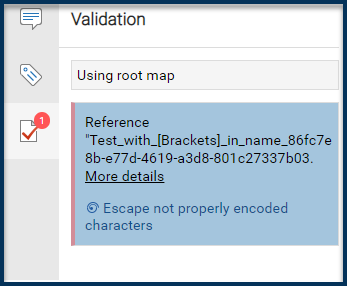Fix map validation errors
When working with maps in the Oxygen-based editor, the editor checks for XML errors and shows you the results in the Validation pane. You can read about common issues with map validation and suggestions for correcting the errors.
To see errors in the validation pane:
Quick fixes
Oxygen XML Web Author includes support for Quick Fixes that help you resolve validation issues in XML documents. You can see the solution the Oxygen editor proposes for automatically solving the issues with one click.
- For any validation item that has a detected Quick Fix, the proposals are listed in the Validation right side panel as links.
- On a desktop device, these links also appear in the tooltip that is displayed when hovering over a problem in the editor.
- For information about common errors that appear in XML documents that are validated against DTD, XSD, or Relax NG schemas, see Quick Fixes for DTD, XSD, and Relax NG Errors.
- Oxygen XML Web Author also supports Schematron Quick Fixes. A developer can create custom Schematron Quick Fixes to help impose Authoring rules and provide quick solutions to fix errors. For more information, in the Oxygen XML Editor User Manual, see the Schematron Quick Fixes (SQF).
Reference Errors
- Square brackets used in file names
 By default, the Oxygen editor displays an error identifying the character that cannot be represented in the specified encoding.
By default, the Oxygen editor displays an error identifying the character that cannot be represented in the specified encoding.- You will see an explanation similar to "contains characters which are not properly URI-encoded".
- To read the Oxygen editor's help on the @href attribute, click More details.
- One of these characters that can cause an error is square brackets ([]).
- You can now use square brackets in a component name and when you add it to a map it won't cause validation errors.
- However, you will have to go back and fix any previously created map references to a component with square brackets in the name.
- You must save a copy of the original file causing the error and re-insert it into the map.
- All new references to a file with square brackets in the name won't cause an error.
To fix a previously referenced component with square brackets:
- Click
 Components.
Components. - In the Folders pane, navigate to the folder where you've saved the component with square brackets in the name.
- In the Components pane, right-click the component and select Save, and then select Save as...
- On the Save component as dialog, by default, the Target Folder is set to the same folder where the existing component is stored. Do one of the following:
- Leave the default.
- Select a new location.
- In New Component Name, enter a unique name for the componen in 100 characters or less.
 You can still use square brackets in the name, but you should alter either the name or location so you can distinguish the new copy from the previous version.
You can still use square brackets in the name, but you should alter either the name or location so you can distinguish the new copy from the previous version. - From the Language list, select the default language for the component.
 When you open this component to edit it, Inspire loads the spelling dictionary for the language you choose here.
When you open this component to edit it, Inspire loads the spelling dictionary for the language you choose here. - Click Create.
 You see the component in the Components browser in the target folder you selected.
You see the component in the Components browser in the target folder you selected. - In the Components pane, navigate to the map with validation errors, and double-click it.
- In the Oxygen map editor, in the center pane, click anywhere in the reference causing the validation error.
- In the left Outline pane, right-click the reference and select
 Delete element.
Delete element. - In the left Outline pane, right-click the reference that was immediately before the element you just deleted, and select Insert after, and from the list select Topic Reference.
- On the Insert reference dialog, click Reference.
- On the Select Components dialog, browse the Folders or use a Search Query to find the new component you created from the one with square brackets in the name.
- Select the component's checkbox, and then click Select.
 The topic you added appears in the center pane.
The topic you added appears in the center pane. In the right pane, the "Escape not properly encoded characters" error should not be listed.
In the right pane, the "Escape not properly encoded characters" error should not be listed. - To save your changes and close the map, click Save and submit
 .
.
 button.
button.